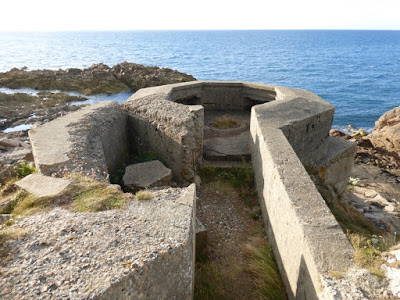The signs of political subdivision say we are still in Normandy. But the granite, the rising land, the rugged coast, the purple heath, and the megaliths all announce we are in Brittany. Just a mile or so from our campsite was our first megalith of this trip, a large and well preserved
allee couverte in the heights near Bretteville. This is as far east as we have seen such a thing here, and never in Normandy. But there it was. An
allee couverte is a covered passage tomb, sometimes a chambered tomb. Typically there would be two rows of megaliths, surmounted by a megalith roof. And typically, the whole would have been buried under a
tumulus or mound. In Brittany,
tumuli have often been mistaken for natural hills. The one near Bretteville has lost it tumulus--most we know of have--but it is in good shape and perhaps 20 meters in length.
 |
We arrived fairly early in the morning and surprised the county maintenance
guy who had just finished mowing and cleaning the place up |
 |
When I produced my camera, he rushed to remove all his work implements, but I
said, non, si vous plait, and he appeared to understand I thought the shovel would
be a nice touch, showing our appreciation of his good work |
 |
| Anyhow, here's the allee couverte from a variety of perspectives |
 |
| Out in a farmer's fields, as they almost always area |
 |
| Big stones; no carving we saw |
 |
| Nice view |
 |
In only one or two bays was the capstone knocked down
or missing |
 |
It's impossible to date these things with precision--once they have been plundered,
probably millennia ago, they have been contaminated or all the datable stuff removed
--in any case, allee couvertes in France generally are thought to be in the 4,000-
6,000 year old range |
























































